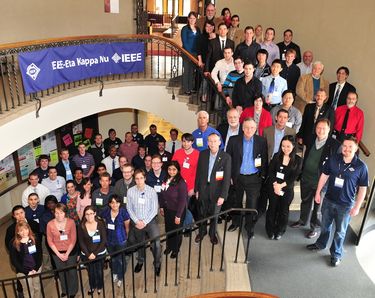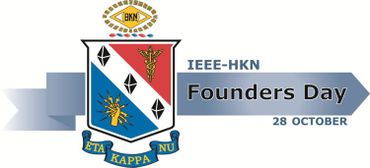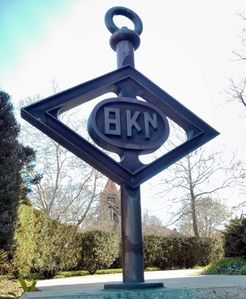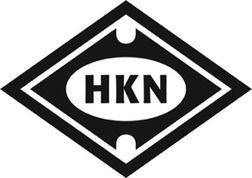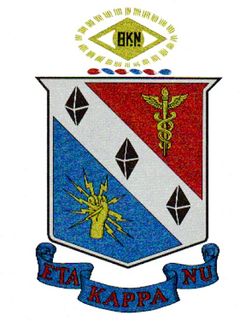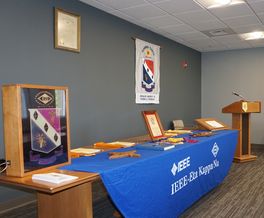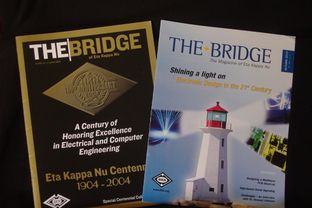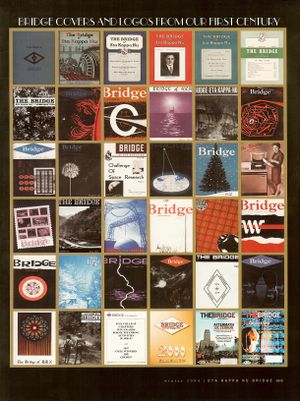Eta Kappa Nu
Introduction
IEEE-Eta Kappa Nu (IEEE-HKN) is the honor society of the Institute of Electrical and Electronics Engineers (IEEE). The organization promotes excellence in the profession and in education through an emphasis on scholarship, character, and attitude. Membership is a lifelong designation for individuals who have distinguished themselves as students or as professionals in electrical engineering, computer engineering, computer science, and other fields of IEEE interest.
Eta Kappa Nu was founded on 28 October 1904 as an independent honor society for electrical engineering. It has expanded its scope through the years and it became an organizational unit within IEEE in 2010 (see Eta Kappa Nu Merger with IEEE) and is governed by the IEEE-Eta Kappa Nu Board of Governors. Over 250 collegiate chapters have been chartered world-wide and more than 200,000 members have been elected to membership. These chapters recognize high scholarship through membership and foster a culture of service and volunteerism within their host departments. They are noted for student-led engagement with peers, faculty, and industry through tutoring, maker-space management, networking events, etc. Most members are inducted as students, but distinguished professionals may be inducted as well. The guiding ideals for membership eligibility of scholarship, character, and attitude have remained unchanged since the early years.
The corporate IEEE-HKN supports the chapters and the profession with a variety of signature activities. An annual Founders Day promotion on the 28thof October encourages chapters to celebrate HKN and to engage in service in their local community. An annual student conference addresses networking, leadership, and professional development objectives. A prominent awards program includes six award categories. An online THE BRIDGE magazine is the archival publication for students, alumni members, and others in the profession and industry.
IEEE-Eta Kappa Nu chapters are present at education institutions of higher learning across the world. Collegiate chapter activities, including the member election process, are organized around the recognition of academic accomplishment, the promotion of ethical behavior and volunteer service, and the development of leadership and collaborative skills. The member induction ceremony states, “This is what we strive for as members of Eta Kappa Nu: to lead a balanced life, a life in which scholarship, character, and attitude are jointly developed.” Student members join their collegiate chapter of IEEE-HKN for reasons including:
- Formal recognition of academic accomplishment,
- Interaction with faculty and successful students,
- Opportunities for leadership experience,
- Organized service projects and service learning,
- Opportunities for professional development, and
- Lifelong professional community within IEEE.
Student membership is valued as an early indicator of career success; many prominent leaders, inventors, and entrepreneurs are HKN.
History of HKN/IEEE-HKN
Eta Kappa Nu was founded on October 28, 1904 as the national honor society for electrical engineering students at the University of Illinois at Urbana-Champaign. Maurice L. Carr and nine other undergraduates formed the first chapter and developed a national structure. Their vision for the honor association combined collegiate engagement with a professional community to aid student and alumni members and to support the general profession. Character and attitude were designated along with scholarship as the three ideals to be recognized and promoted through membership and activity. Hence, HKN is concerned with more than simply scholarship and the collegiate experience. It was a member of the Association of College Honor Societies (ACHS) for 1947-2010.
The ten founding members were Maurice L. Carr, Charles E. Armstrong, Ralph E. Bowser, Carl K. Brydges, William T. Burnett, Hibbard S. Greene, Frank W. Winders, Edmund B. Wheeler, Milton K. Akers, and Fred D. Smith. The designation of the first chapter at the University of Illinois is the Alpha Chapter. Subsequent chapters were designated by a Greek letter or letters. An at-large chapter is administered by the HKN Board and is designated the Eta Chapter.
The first century of Eta Kappa Nu began with two of the founders, M. L. Carr and Edmund B. Wheeler, serving as the first and second national presidents, respectively. The next chapters were chartered at Purdue University (Beta Chapter), Ohio State University (Gamma Chapter), and Illinois Institute of Technology Delta Chapter). By the centennial in 2004, more than 200 student chapters as well as several alumni chapters had been chartered. These chapters have sustained records of local service and engagement activities. The national organization developed prominent awards for chapters, students, teachers, young professionals, and service in electrical engineering. Also, HKN created a membership path for professionals and an Eminent Member recognition for career accomplishments. The early history of HKN is described in History of Eta Kappa Nu by Larry Dwon. A video records the Silver Anniversary meeting of Eta Kappa Nu; a career guidance film, Engineering - A Career for Tomorrow, was produced to commemorate the golden anniversary; and a pre-college outreach film, Engineering - The Challenge of the Future, was produced in 1968.
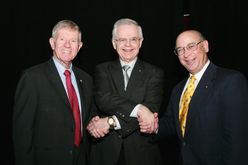
The second century of Eta Kappa Nu has a continued emphasis on the original vision, but the program and structure have been modified. Its signature activities have been revised including special attention on service and student conferences. It has formalized a relationship within IEEE as an organizational unit in which HKN is now IEEE-HKN and is governed by the IEEE-HKN Board of Governors. The merger agreement was signed on 14 February 2009 and it went into effect on 1 September 2010. A restricted endowment was created in the IEEE Foundation to support HKN’s educational, societal, and recognition activities. As a result of the 2010 merger, chapters are being chartered internationally and membership eligibility is expanded to IEEE fields of interest. The headquarters was moved to IEEE, Piscataway, NJ USA.
Symbols of IEEE-HKN
Eta Kappa Nu was founded in 1904 as the honor society for electrical engineering although the scope has since expanded to include related fields. The name is based on the Greek word for amber “elektron” from which the English words “electron,” electricity,” and “electronic” are derived. In Greek, the word is HL E KT P O N
The first, fourth, and last letters form the society name of Eta Kappa Nu which is abbreviated HKN. The emblem is a stylized representation of a Wheatstone bridge. This circuit is used to determine an unknown resistance from three known resistances. A membership analogy is made in which career success is determined when a balance of scholarship, character, and attitude is achieved. These three ideals are the basis for member eligibility.
The shield of HKN dates from 1927 and symbolizes several aspect of HKN history. The three ideals are represented prominently by the three cubes of magnetite in the diagonal band and are also represented in the emblem atop the shield. (Early forms of the Greek letters are used in the center of this version.) The caduceus in honor point of the shield is a memorial to founder Maurice L. Carr who favored this symbol. The hand of Jupiter stands for the first chapter Alpha and the ten lightning bolts refer to the original ten founding members. The shield incorporates the colors for HKN - navy blue to represent loyalty and scarlet to represent zeal. Student members will often wear honor cords in these colors at their graduation. Members are encouraged to wear pins of either the emblem or the shield.
A ceremony is the last step in members’ entry into HKN. An induction ritual reviews the history, the three ideals, and the symbols as described here. In addition, the induction officials will speak as avatars, or in the voice, of selected historical individuals. This HKN review and the use of avatars reflect an intention to honor and to remember the contributions of the past.
Recognition and Awards
IEEE-Eta Kappa Nu membership is an honor-society recognition and is by qualification, election, and induction. Any collegiate chapter may conduct the membership process for undergraduates, graduate students, and professional members. Minimum scholastic or professional qualifications are defined. A chapter may set higher scholastic or career qualifications and will evaluate the character and attitude qualifications locally. An alumni chapter or the Board of Governors may conduct a membership process for professional members. The chapter designation for members inducted by the Board of Governors directly is the Eta Chapter. During the induction ceremony, new members commit themselves to the ideals of HKN.
An Eminent Member category was approved as the highest membership grade in 1941 and the first recognitions were in 1950. This grade is reserved for “those individuals, who by their technical attainments and contributions to society, have shown themselves to be outstanding leaders in an IEEE-designed field of interest, and great benefactors to society.” Individuals must be recognized during their lifetimes for the Eminent Member category; deceased individuals may be recognized as Honorary Eminent Members. The early Eminent Members were documented at the 100thanniversary of HKN in Profiles in Engineering Leadership: Eta Kappa Nu's First Century Eminent Members.
IEEE-HKN has an annual awards program to honor accomplishment related to the Eta Kappa Nu vision. The initial award category was created in 1932 for outstanding chapter activities. The six award categories are shown below. Several awards are named for important HKN volunteers.
- Outstanding Chapter Award, established in 1932.
- Alton B. Zerby and Carl T. Koerner Outstanding Student Award, established in 1965.
- C. Holmes MacDonald Outstanding Teacher Award, established in 1972
- Outstanding Young Professional Award, established in 1936.
- Distinguished Service Award, established in 1971.
- Asad M. Madni Outstanding Technical Achievement and Excellence Award, established 2019.
Typically, these awards are presented annually.
Chapters which engage in best practices and demonstrate high activity are recognized with Key Chapter status. This recognition was established in 2014.
Chapter advisors who demonstrate long-term, effective guidance for HKN chapters are recognized as Advisors of Distinction. This recognition was established in 2025.
Retired awards are shown below.
- Norman R. Carson Outstanding Electrical Engineering Junior Award, Established 1985 and retired 2006.
- Vladimir Karapetoff Technical Achievement Award, established in 1992 and retired in 2019.
THE BRIDGE Magazine
THE BRIDGE magazine is an open-access publication of IEEE and is the archival, flagship publication of IEEE-Eta Kappa Nu. Features relate to technical, historical, and professional interests of the membership and other content deals with activities of the organization. Chapters, student members, and alumni are welcome to submit potential content. Alton B. Zerby, Executive Secretary 1934-1958, wrote that the magazine started “as a vehicle of communication between students and alumni.” It continues to connect students and alumni, as well as to promote the activities and recognition programs of IEEE-HKN and to highlight the development of technology and the profession. The magazine is managed by volunteers, an Editor-in-Chief and an Editorial Board (standing committee of IEEE-HKN), with assistance from the IEEE-HKN Director and other staff.
The history of the magazine dates back to the first publication of Eta Kappa Nu which was a short booklet entitled The Electric Field. This name continued until 1908. The name of The Eta Kappa Nu Yearbook was used briefly. The first use of THE BRIDGE as the publication name occurred in 1910. The volume label was added later and the volume count dates to the publication year of 1905. The number of issues per year has varied from one to four. Originally a print publication, the magazine became electronic-only after the HKN merger with IEEE in 2010. Recent issues have won numerous international awards for excellence.
Previous Issues
1920s
- The Bridge - Vol. 21 - No. 3 - Mar 1925
- The Bridge - Vol. 21 - No. 4 - May 1925
- The Bridge - Vol. 23 - No. 1 - Nov 1926
1950s
1960s
- The Bridge - Vol. 58 - No. 4 - Summer 1962
- The Bridge - Vol. 59 - No. 3 - Spring 1963
- The Bridge - Vol. 61 - No. 3 - Spring 1965
- The Bridge - Vol. 61 - No. 4 - Summer 1965
- The Bridge - Vol. 62 - No. 1 - Nov 1965
- The Bridge - Vol. 62 - No. 2 - Feb 1966
- The Bridge - Vol. 62 - No. 3 - May 1966
- The Bridge - Vol. 62 - No. 4 - Aug 1966
- The Bridge - Vol. 63 - No. 1 - Nov 1966
- The Bridge - Vol. 63 - No. 2 - Feb 1967
- The Bridge - Vol. 63 - No. 4 - Aug 1967
- The Bridge - Vol. 64 - No. 1 - Nov 1967
- The Bridge - Vol. 64 - No. 2 - Feb 1968
- The Bridge - Vol. 64 - No. 3 - May 1968
- The Bridge - Vol. 64 - No. 4 - Aug 1968
- The Bridge - Vol. 65 - No. 1 - Nov 1968
- The Bridge - Vol. 66 - No. 1 - Nov 1969
1970s
- The Bridge - Vol. 66 - No. 3 - May 1970
- The Bridge - Vol. 66 - No. 4 - Aug 1970
- The Bridge - Vol. 67 - No. 2 - Feb 1971
- The Bridge - Vol. 68 - No. 3 - May 1972
- The Bridge - Vol. 71 - No. 2 - Feb 1975
- The Bridge - Vol. 72 - No. 4 - Aug 1976
- The Bridge - Vol. 73 - No. 2 - Feb 1977
- The Bridge - Vol. 73 - No. 3 - Spring 1977
- The Bridge - Vol. 73 - No. 4 - Aug 1977
- The Bridge - Vol. 74 - No. 1 - Nov 1977
- The Bridge - Vol. 74 - No. 2 - Feb 1978
- The Bridge - Vol. 74 - No. 3 - Spring 1978
- The Bridge - Vol. 74 - No. 4 - August 1978
- The Bridge - Vol. 75 - No. 2 - Feb 1979
- The Bridge - Vol. 75 - No. 3 - Spring 1979
- The Bridge - Vol. 75 - No. 4 - Aug 1979
1980s
- The Bridge - Vol. 76 - No. 2 - Feb 1980
- The Bridge - Vol. 76 - No. 4 - Aug 1980
- The Bridge - Vol. 77 - No. 1 - Nov 1980
- The Bridge - Vol. 77 - No. 3 - Spring 1981
- The Bridge - Vol. 78 - No. 1 - Nov 1981
- The Bridge - Vol. 78 - No. 2 - Feb 1982
- The Bridge - Vol. 79 - No. 2 - Feb 1983
- The Bridge - Vol. 79 - No. 3 - Spring 1983
- The Bridge - Vol. 79 - No. 4 - Aug 1983
- The Bridge - Vol. 80 - No. 1 - Nov 1983
- The Bridge - Vol. 80 - No. 2 - Feb 1984
- The Bridge - Vol. 80 - No. 3 - Spring 1984
- The Bridge - Vol. 81 - No. 1 - Nov 1984
- The Bridge - Vol. 81 - No. 2 - Feb 1985
- The Bridge - Vol. 81 - No. 3 - Spring 1985
- The Bridge - Vol. 81 - No. 4 - Aug 1985
- The Bridge - Vol. 82 - No. 1 - Nov 1985
- The Bridge - Vol. 82 - No. 2 - Feb 1986
- The Bridge - Vol. 82 - No. 3 - Spring 1986
- The Bridge - Vol. 82 - No. 4 - Aug 1986
- The Bridge - Vol. 83 - No. 1 - Nov 1986
- The Bridge - Vol. 83 - No. 2 - Feb 1987
- The Bridge - Vol. 83 - No. 3 - Spring 1987
- The Bridge - Vol. 83 - No. 4 - Aug 1987
- The Bridge - Vol. 84 - No. 1 - Nov 1987
- The Bridge - Vol. 84 - No. 2 - Feb 1988
- The Bridge - Vol. 84 - No. 3 - May 1988
- The Bridge - Vol. 84 - No. 4 - Aug 1988
- The Bridge - Vol. 85 - No. 1 - Nov 1988
- The Bridge - Vol. 85 - No. 2 - Feb 1989
- The Bridge - Vol. 85 - No. 3 - May 1989
- The Bridge - Vol. 85 - No. 4 - Aug 1989
- The Bridge - Vol. 86 - No. 1 - Nov 1989
1990s
- The Bridge - Vol. 86 - No. 2 - Feb 1990
- The Bridge - Vol. 86 - No. 3 - May 1990
- The Bridge - Vol. 86 - No. 4 - Aug 1990
- The Bridge - Vol. 87 - No. 1 - Nov 1990
- The Bridge - Vol. 87 - No. 3 - May 1991
- The Bridge - Vol. 87 - No. 4 - Aug 1991
- The Bridge - Vol. 88 - No. 2 - Feb 1992
- The Bridge - Vol. 88 - No. 3 - May 1992
- The Bridge - Vol. 88 - No. 4 - Aug 1992
- The Bridge - Vol. 89 - No. 1 - Nov 1992
- The Bridge - Vol. 89 - No. 3 - May 1993
- The Bridge - Vol. 89 - No. 4 - Aug 1993
- The Bridge - Vol. 90 - No. 1 - Nov 1993
- The Bridge - Vol. 90 - No. 2 - Feb 1994
- The Bridge - Vol. 90 - No. 3 - May 1994
- The Bridge - Vol. 90 - No. 4 - Aug 1994
- The Bridge - Vol. 91 - No. 1 - Nov 1994
- The Bridge - Vol. 91 - No. 2 - Feb 1995
- The Bridge - Vol. 91 - No. 3 - May 1995
- The Bridge - Vol. 91 - No. 4 - Aug 1995
- The Bridge - Vol. 92 - No. 1 - Nov 1995
- The Bridge - Vol. 92 - No. 2 - Feb 1996
- The Bridge - Vol. 92 - No. 3 - May 1996
- The Bridge - Vol. 92 - No. 4 - Aug 1996
- The Bridge - Vol. 93 - No. 1 - Nov 1996
- The Bridge - Vol. 93 - No. 2 - Feb 1997
- The Bridge - Vol. 93 - No. 3 - May 1997
- The Bridge - Vol. 93 - No. 4 - Aug 1997
- The Bridge - Vol. 94 - No. 1 - Nov 1997
- The Bridge - Vol. 94 - No. 2 - Feb 1998
- The Bridge - Vol. 94 - No. 3 - May 1998
- The Bridge - Vol. 94 - No. 4 - Aug 1998
- The Bridge - Vol. 95 - No. 1 - Nov 1998
- The Bridge - Vol. 95 - No. 2 - Feb 1999
- The Bridge - Vol. 95 - No. 3 - May 1999
- The Bridge - Vol. 96 - No. 1 - Nov 1999
2000s
- The Bridge - Vol. 96 - No. 2 - Summer 2000
- The Bridge - Vol. 96 - No. 3 - Fall 2000
- The Bridge - Vol. 97 - No. 1 - Summer 2001
- The Bridge - Vol. 97 - No. 2 - Winter 2002
- The Bridge - Vol. 98 - No. 1 - 2002
- The Bridge - Vol. 98 - No. 2 - Summer 2003
- The Bridge - Vol. 99 - No. 1 - Winter 2003
- The Bridge - Vol. 99 - No. 2 - Summer 2004
- The Bridge - Vol. 100 - No. 1 - Winter 2004
- The Bridge - Vol. 101 - No. 1 - Autumn 2005
- The Bridge - Vol. 101 - No. 2 - Spring 2006
- The Bridge - Vol. 102 - No. 1 - Autumn 2006
- The Bridge - Vol. 102 - No. 2 - Spring 2007
- The Bridge - Vol. 103 - No. 1 - Autumn 2007
- The Bridge - Vol. 103 - No. 2 - Spring 2008
- The Bridge - Vol. 104 - No. 1 - Autumn 2008
- The Bridge - Vol. 104 - No. 2 - Spring 2009
- The Bridge - Vol. 105 - No. 1 - Autumn 2009
2010s
- The Bridge - Vol. 105 - No. 2 - Spring 2010
- The Bridge - Vol. 106 - No. 1 - Autumn 2010
- The Bridge - Vol. 108 - No. 1 - May 2012
- The Bridge - Vol 109 - No. 4 - 2013-2014
HKN/IEEE-HKN Governance
IEEE-Eta Kappa Nu is currently governed as an organizational unit of IEEE by a Board of Governors (BOGs). The IEEE-HKN BOGs consists of thirteen voting members and two ex-officio members. The voting members are elected by the chapters and consist of president, president-elect, immediate past president, governor Regions 1-2, governor Regions 3-4, governor Regions 5-6, governor Regions 7-10, four at-large governors, and two student governors. The ex-officio members are the IEEE Vice-President of Educational Activities and the IEEE-HKN Director.
The first paid staff position for the organization was created in 1928. The executive secretaries/directors of Eta Kappa Nu and IEEE-Eta Kappa Nu are listed below with their years of service.
- J. A. Umhoefer, 1928-1931.
- Leyland A. Spangler, 1931-1934.
- Alton B. Zerby, 1934-1958.
- Paul Hudson, 1958-1988.
- J. Robert Betten, 1988-1999.
- Ron A. Spanke, 2000-2005.
- Robert M. Janowiak, 2005-2006.
- Roger L Plummer, 2006-2010.
- Fern Katronetsky, 2010-2011.
- Nancy M. Ostin, 2012-Present.
The presidents of HKN/IEEE-HKN are listed below
| Term | President | Affiliation while President | Chapter of Induction |
| 2026 | James Jefferies | AT&T and Lucent Technologies (retired) | Beta Psi '68 |
| 2025 | Sean J. Bentley | Adelphi University | Gamma Theta '94 |
| 2024 | M. Ryan Bales | Georgia Tech Research Institute | Gamma Theta '03 |
| 2023 | Sampathkumar Veeraraghavan | Amazon | Epsilon Delta '13 |
| 2022 | James M. Conrad | University of North Caroline at Charlotte | Beta Eta '89 |
| 2021 | Ronald G. Jensen | IBM (retired) | Nu '72 |
| 2020 | Edward A. Rezek | Northrop Grumman (retired) | Delta Zeta '75 |
| 2019 | Karen A. Panetta | Tufts University | Epsilon Delta '95 |
| 2018 | Steve E. Watkins | Missouri University of S&T | Gamma Theta ‘82 |
| 2017 | Timothy P. Kurzweg | Drexel University | Epsilon '94 |
| 2016 | S. K. Ramesh | California State University, Northridge | Lambda Beta '08 |
| 2015 | Evelyn H. Hirt | DoE Pacific Northwest Nat’l Lab | Beta Sigma '74 |
| 2013-2014 | John A. Orr | Worcester Plytechnic University | Alpha '67 |
| 2011-2012 | Stephen M. Goodnick | Arizona State University | Pi '90 |
| 2008-2010 | Bruce A. Eisenstein | Drexel University | Beta Alpha '68 |
| 2006-2008 | J. David Irwin | Auburn University | Xi '60 |
| 2004-2006 | Karl E. Martersteck | Eta | |
| 2003-2004 | Eric Hertz | IEEE | Zeta Sigma |
| 2002-2003 | Thomas L. Rothwell | Hughes Aircraft Company | Upsilon '53 |
| 2001-2002 | James L. Melsa | Iowa State University | Nu '60 |
| 2000-2001 | Mohammad Shahidehpour | Illinois Institute of Technology | Iota |
| 1998-2000 | Richard J. Gowen | South Dakota School of Mines and Technology | Gamma Epsilon '57 |
| 1997-1998 | John D. Wolf | Teledesic Corporation | Gamma Theta '66 |
| 1996-1997 | Robert I. Egbert | Wichita State University | Gamma Theta '71 |
| 1995-1996 | Michael R. Hajny | Beta Epsilon '73 | |
| 1994-1995 | Bruce P. Johnson | Eta '81 | |
| 1993-1994 | David G. Meyer | Purdue University | Beta '77 |
| 1992-1993 | Laureen H. Parker | Motorola | Psi '82 |
| 1991-1992 | James A. D'Arcy | GE Astro Space | Delta Mu '63 |
| 1990-1991 | Robert F. Arehart | Beta Alpha '50 | |
| 1989-1990 | Robert J. Kennerknecht | Mu '58 | |
| 1988-1989 | Virgil G. Ellerbruch | Gamma Rho '68 | |
| 1987-1988 | Harold K. Knudsen | Mu '57 | |
| 1986-1987 | Alan Lefkow | Singer Kearfott Inc (New Jersey) | Beta Pi '63 |
| 1985-1986 | Joanne L. Waite | University of Colorado Boulder | Rho '67 |
| 1984-1985 | Earl L. Steele | University of Kentucky | Gamma Sigma |
| 1983-1984 | Paul B. Jacob, Jr. | Mississippi State University | Beta Tau '48 |
| 1982-1983 | J. Robert Betten | University of Missouri-Rolla | Nu '55 |
| 1981-1982 | Russell E. Lueg | Psi '55 | |
| 1980-1981 | Sydney R. Parker | Beta Pi '46 | |
| 1979-1980 | Alan R. Stoudinger | Tri-State University (Indiana) | Zeta Phi '75 |
| 1978-1979 | Albert Hauser | Delta | |
| 1977-1978 | Marcus D. Dodson | Beta Upsilon '49 | |
| 1976-1977 | Earl D. Eyman | Ryo '65 | |
| 1975-1976 | Chalmers M. Butler | Zeta Iota | |
| 1974-1975 | William A. Klos | Epsilon Epsilon | |
| 1973-1974 | William E. Murray | Mu '47 | |
| 1972-1973 | Frank Carlin Weimer | Gamma '39 | |
| 1971-1972 | Lloyd B. Cherry | Omega | |
| 1970-1971 | Anthony F. Gabrielle | Beta Theta | |
| 1969-1970 | John C. Hancock | Purdue University | Beta |
| 1968-1969 | John "Jack" E. Farley | Illinois Bell Telephone Company | Alpha '47 |
| 1967-1968 | William P. Smith | University of Kansas | Omicron '34 |
| 1966-1967 | Clyde M. Hyde | International Business Machines | |
| 1965-1966 | Howard H. Sheppard | Rumsey Electric Company | Lambda '31 |
| 1964-1965 | Richard J. Koopman | Washington University, St. Louis | Beta Gamma '36 |
| 1963-1964 | John E. Lagerstrom | Nu '43 | |
| 1962-1963 | John A. M. Lyon | University of Michigan, Ann Arbor | Beta Tau |
| 1961-1962 | John H. Craig | Ohio Bell Telephone | Beta Theta '39 |
| 1959-1961 | Albrecht Naeter | ||
| 1958-1959 | Larry Dwon | Kappa '35 | |
| 1957-1958 | Carl T. Koerner | Kappa '30 | |
| 1956-1957 | John D. Ryder | Gamma '27 | |
| 1955-1956 | S. Reid Warren, Jr. | Lambda '28 | |
| 1954-1955 | Jesse Hobson | Beta '32 | |
| 1953-1954 | Eric T. B. Gross | Kappa '45 | |
| 1952-1953 | Edwin B. Kurtz | Beta Iota | |
| 1951-1952 | Ovid W. Eshbach | Northwestern University | Chi |
| 1950-1951 | Frank E. Sanford | Tau '26 | |
| 1949-1950 | Robin Beach | Beta Beta | |
| 1948-1949 | Thomas W. Williams | Lambda '22 | |
| 1947-1948 | Nelson S. Hibshman | Epsilon '24 | |
| 1946-1947 | Ralph W. Fouse | Epsilon '25 | |
| 1945-1946 | Owen H. Loynes | Theta '16 | |
| 1944-1945 | Winston E. Kock | Tau '32 | |
| 1943-1944 | Charles B. Hoffman | Tau | |
| 1942-1943 | Fred E. Harrell | Beta '24 | |
| 1940-1942 | Francis X. Burke | Beta '13 | |
| 1939-1940 | Benjamin F. Lewis | Kappa '21 | |
| 1938-1939 | Leland A. Spangler | Nu '21 | |
| 1937-1938 | A. Morris Buck | Alpha | |
| 1935-1937 | Clifford A. Faust | Nu '27 | |
| 1934-1935 | Nelson L. Best | Mu '24 | |
| 1933-1934 | Roger I. Wilkinson | Nu '24 | |
| 1932-1933 | John M. Newman | Omicron '22 | |
| 1931-1932 | Edward F. Watson | Kappa '14 | |
| 1930-1931 | George H. Kelley | Delta '22 | |
| 1929-1930 | Mayne S. Mason | Alpha '11 | |
| 1928-1929 | John W. Weigt | Kapa '18 | |
| 1927-1928 | Everett S. Lee | Alpha '13 | |
| 1926-1927 | Forrest E. Brooks | Zta '12 | |
| 1925-1926 | Axel A. Hofgren | Delta '18 | |
| 1924-1925 | George P. Sawyer | Alpha '11 | |
| 1923-1924 | Joseph B. Kelly | Epsilon '17 | |
| 1922-1923 | Donald G. Evans | Alpha '17 | |
| 1921-1922 | John M. Spangler | Epsilon '11 | |
| 1920-1921 | Burt T. Anderson | Alpha '07 | |
| 1919 | L. Paton MacGilvary (d. 1919) | Theta '16 | |
| 1918-1919 | Francis A. Coffin | Alpha '09 | |
| 1917-1918 | Henry S. Cocklin | Epsilon '12 | |
| 1916-1917 | Bert E. Miller | Theta '11 | |
| 1915-1916 | Roscoe H. Webb | Beta '08 | |
| 1914-1915 | Alton B. Zerby | Westinghouse | Epsilon '11 |
| 1913-1914 | Albert H. Heitmann | Gamma "09 | |
| 1912--1913 | Leslie H. Harris | Beta '07 | |
| 1911-1912 | Burt T. Anderson | Alpha '07 | |
| 1910-1911 | Clarence T. Evans | Gamma '08 | |
| 1909-1910 | Charles C. Carr | Alpha '06 | |
| 1908-1909 | A. F. McKee | Beta '17 | |
| 1907-1908 | Charles E. Armstrong | Alpha '05 | |
| 1906-1907 | Edmund B. Wheeler | Western Electric Company | Alpha '05 |
| 1905-1906 | Maurice L. Carr | Alpha '05 |
Eminent Members
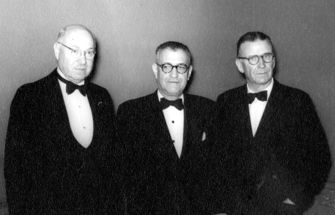
The category of Eminent Member was proposed by three members of the Eta Kappa Nu National Executive Council, Morris Buck, B. F. Lewis, and Alton B. Zerby. It was approved in 1941 by means of an article in the Eta Kappa Nu constitution. The article stated in part: “Eminent membership may be offered only to those individuals who by their attainments and contributions to society have shown themselves to be outstanding leaders in the field of electrical engineering and great benefactors to their fellow men.” Today “electrical engineering” is construed to encompass electrical and computer engineering.
It was not until 1950 that the first Eminent Members were inducted. Other priorities during World War II and the years immediately following were thought to be at the root of the delay. Also, in the interim the criteria for selection and the process by which candidates were to be nominated and approved needed to be determined, and a ceremony befitting the honor had to be designed.
The first three Eminent Members were inducted by Eta Kappa Nu president Robin Beach. They were Vannevar Bush, Royal W. Sorensen, and Vladimir K. Zworykin. Assisting in the ceremony were A. B. Zerby, F. E. Sanford, E. B. Kurtz, T. W. Williams, and Eric T. B. Gross. The inductees were escorted by C. F. Dalziel, Everett M. Strong, and Eric T. B. Gross. An account of the event appeared in the March, 1950 issue of THE BRIDGE. Only living individuals may be elevated. An additional ten individuals have been designated Honorary Eminent Members since they were not considered during their lifetimes.
Candidates for election to Eminent Member are brought to the IEEE-HKN Board of Governors by the Eminent Member Committee. Eminent Member candidates are judged for their leadership and accomplishments in one or more of several areas: innovation and invention, education, professional society activities, government service, and the corporate world. Each Eminent Member-Elect is inducted at a ceremony conducted by the president of Eta Kappa Nu or his designee.
List of Eminent Members
- Alexanderson, Ernst
- Alger, Philip L.
- Amdahl, Gene
- Augustine, Norman R.
- Bachman, Henry Lee
- Baker, Walter R. G.
- Bardeen, John
- Bell, Chester Gordon
- Beranek, Leo L.
- Berkner, Lloyd V.
- Beverage, Harold Henry
- Black, James
- Bordogna, Joseph
- Bose, Amar
- Brillouin, Leon N.
- Brown, George H.
- Brown, Gordon
- Bucy Jr., J. Fred
- Burns, John L.
- Bush, Vannevar
- Cerf, Vinton G.
- Christiansen, Donald
- Cisler, Walker L.
- Concordia, Charles
- Coolidge, William D.
- Cooper, Martin
- Currie, Malcolm R.
- David, Jr., Edward E.
- De Forest, Lee
- Dellinger, John Howard
- Dodson, Marcus D.
- Dommel, Hermann W.
- DuBridge, Lee A.
- Dwon, Larry
- Edgerton, Harold E.
- Erdelyi, Edward A.
- Estrin, Thelma
- Ettus, Matt
- Everitt, William L.
- Fink, Donald G.
- Flanagan, James L.
- Forney Jr., G. David
- Frosch, Robert
- Garriott, Owen K.
- Getting, Ivan
- Goldsmith, Alfred N.
- Gordon, Bernard M.
- Gowen, Richard J.
- Graham, Susan L.
- Greatbatch, Wilson
- Gross, Eric T. B.
- Haggerty, Patrick E.
- Heilmeier, George H.
- Herz, Eric
- Hewlett, William R.
- Hillier, James
- Hoff, Marican E. "Ted"
- Hogan, C. Lester
- Holonyak, Jr., Nick
- Hood, Clifford
- Jacobs, Irwin
- Jamieson, Leah H.
- Jordan, Edward C.
- Kahn, Robert
- Kailath, Thomas
- Kanouse, Edgar L.
- Kelly, Mervin
- Kilby, Jack St. Clair
- Kleinrock, Leonard
- Kock, Winston E.
- Kohli, Faqir Chand
- Kouwenhoven, William B.
- Kurzweil, Ray
- Lee, Everett S.
- Lempel, Abraham
- Lucky, Robert W.
- Madni, Asad M.
- McClellen, Leslie N.
- McEachron, Karl
- Meindl, James D.
- Metcalfe, Robert
- Mergler, Henry W.
- Molina, Edward
- Moore, Arthur Dearth
- Moore, Gordon E.
- Mortenson, Soren H.
- Murphy, N. R. Narayana
- Murray, William E.
- Nakahara, Tsuneo
- Nyquist, Harry
- Osborne, Harold
- Paine, Ellery
- Pederson, Donald O.
- Pender, Harold
- Pickering, William H.
- Pierce, John R.
- Piore, Emanuel R.
- Poor, H. Vincent
- Posakony, Gerald
- Potter, Andrey Abraham
- Powel, Charles A.
- Purcell, Edward M.
- Quarles, Donald A.
- Rabinow, Jacob
- Ramo, Simon
- Read, Wallace S.
- Rechtin, Eberhardt
- Rudenberg, Rienhold
- Sage, Andrew P.
- Sample, Steven Browning
- Samueli, Henry
- [Roland W. Schmitt|Schmitt, Roland]]
- Schwartz, Mischa
- Scifres, Donald R.
- Seo, Jung Uk
- Sheffield, Berthold
- Sheppard, Howard H.
- Slaughter, John B.
- Slepian, Joseph
- Sorensen, Royal W.
- Sporn, Philip
- Starr, Chauncey
- Stratton, Julius A.
- Suran, Jerome
- Terman, Frederick
- Timbie, William
- Townes, Charles
- Valdez C., Jose F.
- Viterbi, Andrew
- Wagner, Charles
- Warren, Samuel Reid
- Weber, Ernst
- Whinnery, John R.
- Whitehead, John B.
- Wiesner, Jerome B.
- Winne, Harry A.
- Wozniak, Steve
- Wulf, William A.
- Zarem, Abe M.
- Zworykin, Vladimir K.
List of Honorary Eminent Members
- Armstrong, Edwin Howard
- Atanasoff, John Vincent
- Bell, Alexander Graham
- Brattain, Walter House
- Edison, Thomas Alva
- Farnsworth, Philo T.
- Hopper, Grace Murray
- Langmuir, Irving
- Noyce, Robert
- Packard, David
Further Reading
- History of Eta Kappa Nu - A book prepared by Larry Dwon in 1976 on the early history of HKN.
- Eta Kappa Nu Merger with IEEE in 2010
- Eta Kappa Nu Photographs, a gallery of photos covering numerous awards ceremonies and other events
- Profiles in Engineering Leadership: Eta Kappa Nu's First Century Eminent Members - A book prepared by the IEEE History Center on behalf of Eta Kappa Nu.
- A Century of Honoring Excellence in Electrical and Computer Engineering, Eta Kappa Nu, 1904-2004
- A History of the Eta Kappa Nu Outstanding Young Electrical Engineer Award, 1936-1986
- Eta Kappa Nu Silver Anniversary, a video of the 25th anniversary meeting of Eta Kappa in 1929, includes placement of the Founders plaque at the University of Illinois.
- Engineering - A Career for Tomorrow, a career guidance film produced by Eta Kappa Nu in 1955 to commemorate the golden anniversary.
- Engineering - The Challenge of the Future, precollege outreach film produced by Eta Kappa Nu in 1968.
- "The Secret Society that never was," John F. Mason, IEEE Spectrum, 16(9), 55-57 (1979).
- "IEEE-HKN: The Electrical and Computer Engineering Honor Society," Steve E. Watkins, IEEE Potentials, 31(4), 19-21 (2012).
- Eta Kappa Nu Web Page, https://hkn.ieee.org.

